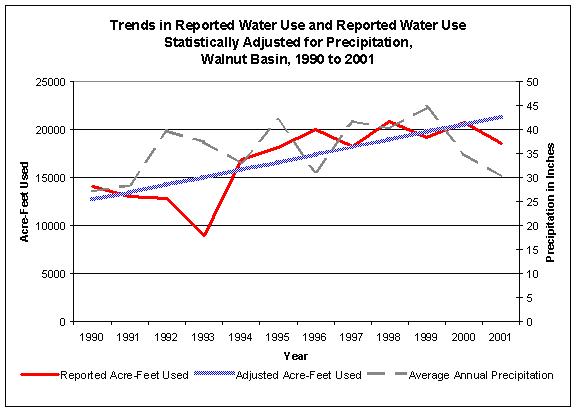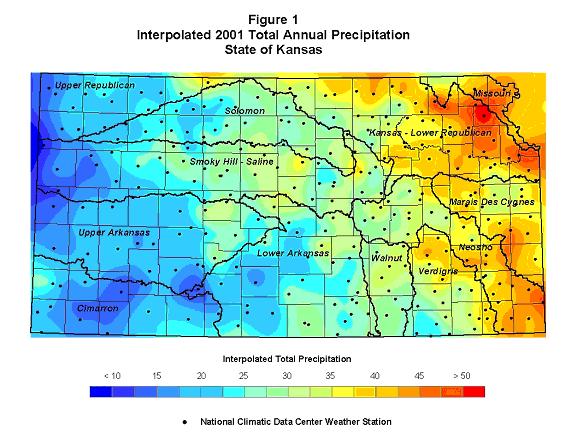
by Brownie Wilson and Geoff Bohling, Kansas Geological Survey.
This open file report is one of five assessment reports under KGS OFR 2003-55 conducted by the Kansas Geological Survey for the Kansas Water Office and the State Water Plan. This report series serves in part as the contract completion of KWO Contract No. 03-121 entitled, "Assessment: Water Management and Water Conservation." This contract was supported by the State Water Plan Fund.
By 2015, achieve sustainable yield management of Kansas surface and ground water sources, outside of the Ogallala aquifer and areas specifically exempt by regulation. Sustainable yield management would be a goal that sets water management criteria to ensure long term trends in water use will move as close as possible to stable ground water levels and maintenance of sufficient stream flows.
INTRODUCTION
In the FY 2003 Kansas Water Plan (KWP), the Kansas Water Authority approved objectives for the year 2010. The objectives were developed to define targets to quantify achievements as part of the implementation of the KWP. The above objective is included in the Water Management Section of the FY 2004 Kansas Water Plan.
In support of this objective, this assessment report reviews trends in reported water use from 1990 to 2001 with the influence of variations in precipitation accounted for. The Kansas Water Office (KWO) used KWP funds to contract with the Kansas Geological Survey to complete and finalize this assessment as part of the contract "Assessment: Water Management and Water Conservation", KWO contract no. 03-121.
ASSESSMENT DATA SETS
All reported water-use data used in this assessment was retrieved from the KDA-DWR's Water Right Information System (WRIS) and represents all uses made of water (i.e. irrigation, municipal, industrial, etc.) and sources of water (ground or surface). The period of 1990 to 2001 was chosen because 1990 was the first year annual water use reports were reviewed as part of the KWO and KDA-DWR cooperative Irrigation and Municipal Water Use Program, a data-quality control and assurance program. 2001 was the most recent year of data available when this assessment was initiated.
All reported water-use information is tied directly to a specific point of diversion (i.e. ground-water well or surface-water pump). However, one of the inherent complexities with water-right data lies in a single point of diversion having multiple water rights authorized to divert water from it. To account for this one-to-many relationship, the annual amount of water reported diverted from each unique point of diversion was totaled for each year from 1990 to 2001. For Kansas as a whole, 42,910 unique points of water diversion turned in a water-use report within this time period.
Total monthly precipitation data was obtained from the National Climate Data Center at http://lwf.ncdc.noaa.gov/oa/ncdc.html. The number of stations in Kansas that contain usable monthly precipitation data varies from year to year and ranges from 265 to 286 stations with an average of 274 for the 1990 to 2001 time period. The monthly values were used calculate total annual precipitation.
Although it is not common, each year
there are times when a total monthly precipitation value was not recorded for
a particular weather station. In consultation with Mary Knapp, State Climatologist
at the KSU Weather Library, missing monthly values were replaced with averages
from surrounding weather stations if a station was missing four or fewer monthly
values during a calendar year. If a weather station was missing more than 4
months of precipitation values during a single calendar year, that year of data
for that station was removed from the data set.
For each year from 1990 to 2001, the annual precipitation values were used to
create continuous 1x1 kilometer gridded surfaces across the state. An example
of the 2001 precipitation surface is shown in Figure 1. Each grid cell contains
an interpolated precipitation value based on the surrounding precipitation values
from the weather stations for that year. These interpolated surfaces were then
used to assign an estimated total annual precipitation value to each unique
point of water diversion.

With the total reported water use and annual precipitation estimated for each
unique point of diversion in Kansas, a statistical regression model was fit
to the data to establish a trend in reported use factoring out the variations
in precipitation. The regression analysis estimated one coefficient describing
the influence of annual precipitation and another describing the remaining annual
trend in water use apart from variations due to precipitation. Adjusted water
use was then computed from the regression equation by replacing the actual annual
precipitation values at each point of diversion with the average annual precipitation
(over the 1990-2001 interval) for that location.
To establish a useful trend, regression equations were calculated for each individual point of diversion if there was a reported measurable use made of water for at least 8 tears out of the 12-year period. The R-squared value for the regression and a measure of the significance of the annual trend term were also recorded. The calculated adjusted water use values were then spatially summarized by KWO planning basin and the State of Kansas.
ASSESSMENT RESULTS
Of the original 42,910 points of
water diversion in Kansas that reported a measurable quantity of water used
from 1990 to 2001, 22,620 had at least 8 years of reported use. The total reported
water use, statistically adjusted to account for variations in annual precipitation,
indicate an overall downward trend as can be seen in Figure 2. However, based
on the individual regression equations established for these 22,620 points of
diversion, only 8,026 or 35.48% had statistically significant annual trends
after factoring out precipitation. For Kansas as a whole, the average R-Square
values for the individual regression equations calculated for each point of
water diversion was 0.3973. This means that about 40 percent of the variations
in water use can be explained by a combination of variations in annual precipitation
and a linear annual trend.

On a regional basis, trends in water use that have been statistically adjusted for variations in annual precipitation have a general east-west spatial division. As can be seen in Table 1, all of the western basins, specifically the Cimarron, Lower Arkansas, Smoky Hill - Saline, Solomon, Upper Arkansas, and the Upper Republican, all have declining trends in the statistically adjusted water use. In contrast, with exception of the Kansas- Lower Republican and Neosho, the eastern Kansas basins have increasing trends in the statistically adjusted water use (graphs showing the individual trends are provided in Appendix A). However, in all cases the total number of points of diversion that had a statistically significant change in reported water use is below 50 percent.
|
Table
1 - Statistical
Summary Results for Reported Water Use, Statistically Adjusted for Annual
Precipitation, By KWO Basin, 1990 to 2001
|
|||||
|
Basin
|
Points
of Diversion a/
|
Points
of Diversion with Significant Change b/
|
Percent
of Significant Change c/
|
Average
Trend d/
|
Average
R-Squared e/
|
| Cimarron |
3892
|
1817
|
46.69%
|
-11.6617
|
0.3881
|
| Kansas - Lower Republican |
1561
|
443
|
28.38%
|
-0.9474
|
0.4054
|
| Lower Arkansas |
3974
|
1011
|
25.44%
|
0.2074
|
0.4372
|
| Marais Des Cygnes |
98
|
46
|
46.94%
|
7.0268
|
0.4576
|
| Missouri |
48
|
12
|
25.00%
|
56.1107
|
0.311
|
| Neosho |
152
|
67
|
44.08%
|
-3.6798
|
0.4072
|
| Smoky Hill - Saline |
2396
|
943
|
39.36%
|
-3.849
|
0.3742
|
| Solomon |
1244
|
508
|
40.84%
|
-2.9948
|
0.4626
|
| Upper Arkansas |
7134
|
2549
|
35.73%
|
-2.8369
|
0.3809
|
| Upper Republican |
2003
|
591
|
29.51%
|
-1.6706
|
0.3728
|
| Verdigris |
61
|
23
|
37.70%
|
6.1667
|
0.3651
|
| Walnut |
57
|
16
|
28.07%
|
13.788
|
0.4607
|
| State of Kansas |
22620
|
8026
|
35.48%
|
-3.4743
|
0.3973
|
| a/ Number
of points of diversion that reported at least 8 years of measurable quantities
of water from 1990 to 2001. b/ Number of points of diversion where the annual trend in reported water use, statistically adjusted for precipitation, was statistically significant. c/ Percentage of points of diversion where the annual trend in reported water use, statistically adjusted for precipitation, was statistically significant. d/ Average annual trend in the statistically adjusted water use. Negative values indicate declining water use, positive values indicate rising water usage. e/ The average R-squared values of the individual regression equations. |
The spatial patterns in the trends of the reported water use statically adjusted for precipitation might be attributed to the use made of water and the source of water in Kansas. In western and south-central Kansas, irrigation is the most common use of water with ground water being the primary source. The majority of this area is locally managed by Groundwater Management Districts where much of the area is closed or restricted to further water development. The combination of enhanced management by the GMDs and the curtailment of continued water right development may account for the overall reduction in the reported water use.
Although at a lower level in terms of the number of points of diversion and amount of water, surface water usage for other non-irrigation uses, specifically municipal and industrial uses, is much more prevalent in eastern Kansas. Most of the area is still open to new development, albeit under some restrictions for surface water usage. As such, water right development can still take place which may account for the increasing trends in the statistically adjusted water usage.
CONCLUSION
Using regression analyses, reported water use from 1990 to 2001 was statistically adjusted to account for variations in total annual precipitation for all points of water diversion in Kansas. Based on points of diversion that had reported a measurable quantity of water used for at least 8 years of 12 years, the overall water use, with variations in annual precipitation accounted for, appears to be declining for the state has a whole. However, of the 22,620 points of diversion used in this assessment, only 8,026 or 35.48% had a statistically significant annual trend. The average R-squared value for all the regression equations used in the assessment was 0.3973.
On a regional scale, all of the western
and south-central KWO planning basins had declining trends in the statistically
adjusted water use while all of the eastern Kansas basins, with the exception
of the Kansas-Lower Republican and the Neosho had rising trends in the statistically
adjusted water use. For all basins, the number of points of diversion where
the change in water use was statistically significant was less than 50 percent.
Return to KGS OFR 2003-55.
Appendix A- Water Use Trends by Basin.
Cimarron Basin

Kansas Lower Republican Basin

Lower Arkansas Basin

Marais Des Cygnes Basin

Missouri Basin

Neosho Basin

Smoky Hill - Saline Basin
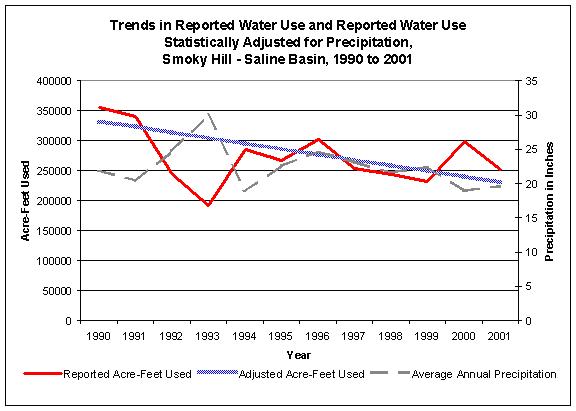
Solomon Basin
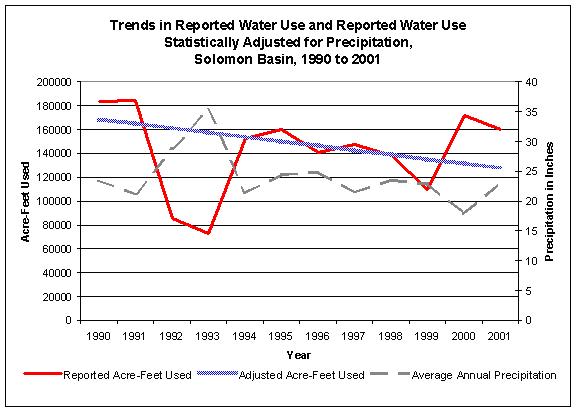
Upper Arkansas Basin

Upper Republican Basin

Verdigris Basin
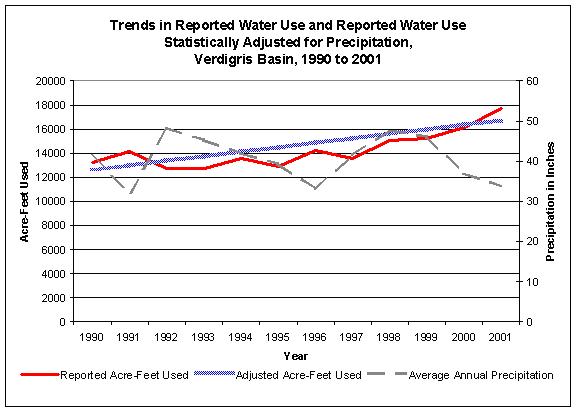
Walnut Basin
